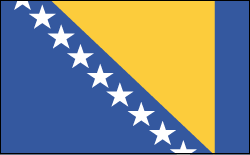Bosnia and Herzegovina History


Ethnic Antgonism Erupts in War
Both the Croatian and Serbian presidents had planned to partition Bosnia between themselves. Attempting to carve out their own enclaves, the Serbian minority, with the help of the Serbian Yugoslav army, took the offensive and laid siege, particularly on Sarajevo, and began its ruthless campaigns of ethnic cleansing, which involved the expulsion or massacre of Muslims. Croats also began carving out their own communities. By the end of Aug. 1992, rebel Bosnian Serbs had conquered over 60% of Bosnia. The war did not begin to wane until NATO stepped in, bombing Serb positions in Bosnia in Aug. and Sept. 1995. Serbs entered the UN safe havens of Tuzla, Zepa, and Srebrenica, where they murdered thousands. About 250,000 died in the war between 1992 and 1995.
U.S.-sponsored peace talks in Dayton, Ohio, led to an agreement in 1995 that called for a Muslim-Croat federation and a Serb entity within the larger federation of Bosnia. Sixty thousand NATO troops were to supervise its implementation. Fighting abated and orderly elections were held in Sept. 1996. President Izetbegovic, a Bosnian Muslim, or Bosniak, won the majority of votes to become the leader of the three-member presidency, each representing one of the three ethnic groups.
But this alliance of unreconstructed enemies had little success in creating a working government or keeping violent clashes in check. The terms of the Dec. 1995 Dayton Peace Accord were largely ignored by Bosnian Serbs, with its former president, arch-nationalist Radovan Karadzic, still in de facto control of the Serbian enclave. Many indicted war criminals, including Karadzic, remain at large. NATO proved to be a largely ineffective peacekeeping force.







